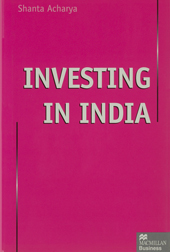Investing In India

- Publisher
- Macmillan Press Ltd., UK; 1998
- ISBN Number
- 0-333-68691-8
- Price
- £50.00
The reforms initiated in 1991 have transformed India's economy and enabled the capital market to assume a larger role in the allocation of capital. India's economic reforms have aimed at improving the nation's productivity which is most likely to create investor wealth in the long term. But, the pace of reforms has been slow due to continual political uncertainty. The book offers a comprehensive assessment of the developments from an investor's viewpoint. The potential of India's stockmarket is examined as the country progresses with economic liberalisation. Six years after reforms, the Indian stockmarket represents no more than ten percent of its economy.
In attempting to forecast the future direction of India's stockmarket, the book analyses the factors that influence it, from reforms in macroeconomic and trade policies to developments in industrial, agricultural, financial, infrastructural and social sector policies since 1991. The book examines to what extent India has been successful in providing a pragmatic set of policies to support the private sector ands with it the potential growth of the stock market. This exclusive analysis of India will be of interest to students and policymakers as much as to anyone interested in investing in one of the major markets to have emerged from its seclusion and opened itself up to global investors.
Contents
- India Today: Facts and Figures
- THE LONG PATH TO ECONOMIC LIBERALISATION
- Introduction
- Historical Background 1947-1991
- Reasons for Failure of India's Mixed Economic Policy
- Laying the Foundations: Recent Economic Developments 1991-1996
- THE MACRO-ECONOMIC STORY: ACHIEVEMENTS AND FAILURES
- Trade, Current Account Balance and External Debt
- Analysis of Government Expenditure and Revenues
- Inflation, Interest Rates and Money Supply Management of the Exchange Rate and Foreign Exchange Reserves
- HOW IS INVESTMENT TO BE FINANCED?
- India's Gross Domestic Savings: Private Savings and Public Savings
- Foreign Savings: The Role of FDI, FII, Country Funds, Venture Capital Funds
- THE CHALLENGES AHEAD
- Improving the Infrastructure
- Investment in the Social Sectors
- Agriculture
- Management of India's Natural Resources and Environmental Issues
- Industrial Policy and Development
- CONCLUSION: ATTRACTIVENESS OF INDIA AS AN INVESTMENT
Reviews
- Contemporary South Asia (UK), Volume 9 Number 2, July 2000. By B K Pandey.
- “India as an investment destination,” The Hindu, (India), July 6, 1999. By S. Ambirajan.
- "Underachieving in a land of plenty," The Times Higher Education Supplement (UK), May 14, 1999, p 33. By Prof Sumit Majumdar.
- Global Custodian (US), 1998/99. By Dominic Hobson